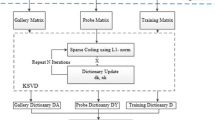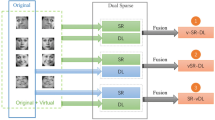Abstract
Dictionary learning has recently attracted a great deal of attention due to its efficacy in sparse representation based image classification task. There are two main limitations of the Sparse Representation based Classification (SRC) for applications. One is that the training data is required to be less corrupted, and the other is that each class should have sufficient training samples. To overcome these two critical issues, we propose a novel approach, namely Discriminative and Common hybrid Dictionary Learning (DCDL), for solving robust face recognition. With the priori target rank information, the DCDL is able to recover a clean discriminative dictionary by exploiting underlying low-rank structure of training data. Simultaneously, the common intra-class variation dictionary is learned to make sure that a query image can be better represented by the collaboration with image variations of other classes. Extensive experiments on representative face databases show that the proposed approach outperforms the state-of-the-art sparse representation based algorithms in dealing with non-occluded face recognition, and yields significant performance improvements in most cases of occluded face recognition.


Similar content being viewed by others
References
Beham MP, Roomi SM (2013) A review of face recognition method. Int J Pattern Recognit Artif Intell 27(04)
Li H, Lin Z, Shen X, Brandt J, Hua G (2015) A convolutional neural network cascade for face detection. Comput Vis Pattern Recognit 5325–5334
Tenenbaum JB, de Silva V, Langford JC (2000) A global geometric framework for nonlinear dimensionality reduction. Science 290(5500):2319–2323
Roweis ST, Saul LK (2000) Nonlinear dimensionality reduction by locally linear embedding. Science 290 (5500):2323–2326
Belhumeur PN, Hepanha JP, Kriegman DJ (1997) Eigenfaces vs. fisherfaces: recognition using class specific linear projection. IEEE Trans Pattern Anal Mach Intell 19(7):711–720
He X, Yan S, Niyogi P, Zhang HJ (2005) Face recognition using laplacianfaces. IEEE Trans Pattern Anal Mach Intell 27(3):328–340
Cai D, He X, Han J (2006) H, Zhang. Orthogonal laplacianfaces for face recognition. IEEE Trans Image Process 15(11):3608– 3614
Zang F, Zhang J, Pan J (2012) Face recognition using Elasticfaces. Pattern Recogn 45(11):3866–3876
Wright J, Yang A, Ganesh A, Sastry S, Ma Y (2009) Robust face recognition via sparse representation. IEEE Trans Pattern Anal Mach Intell 31(2):210–227
Candes EJ, Li X, Ma Y, Wright J (2011) Robust principal component analysis. J ACM 58(3):1–37
Peng Y, Ganesh A, Wright J, Xu W, Ma Y (2010) RASL: robust alignment by sparse and low-rank decomposition for linearly correlated images. In: IEEE Conference on computer vision and pattern recognition, pp 763–770
Zhang Z, Ganesh A, Liang X, Ma Y (2010) TILT: transform invariant low-rank textures. Asian Conf Comput Vis 314–328
Ji H, Liu C, Shen Z, Xu Y (2010) Robust video denoising using Low rank matrix completioni. In: IEEE Conference on computer vision and pattern recognition, pp 1791–1798
Chen C, Wei C, Wang Y (2011) Low-rank matrix recovey with structural incoherence for robust face recognition. In: IEEE Conference on computer vision and pattern recognition, pp 2618–2625
Ma L, Wang C, Xiao B, Zhou W (2012) Sparse representation for face recognition based on discriminative low-rank dictionary learning. In: IEEE Conference on computer vision and pattern recognition, pp 2586–2593
Chen J, Zhang Y (2014) Sparse representation for face recognition by discriminative low-rank matrix recovery. J Vis Commun Image Represent 25(5):763–773
Zhang Y, Jiang Z, Davis L (2013) Learning structured low-rank representations for image classification. In: IEEE Conference on computer vision and pattern recognition, pp 676–683
Candes EJ, Romberg J, Tao T (2006) Stable signal recovery from incomplete and inaccurate measurements. Commun Pure Appl Math 59(8):1207–1223
Chandrasekaran V, Sanghavi S, Parrilo P, Willsky A (2011) Rank-sparsity incoherence for matrix decomposition. SIAM J Optim 21(2):572–596
Wu L, Ganesh A, Shi B, Matsushita Y, Wang Y, Ma Y (2010) Robust photometric stereo via low-rank matrix completion and recovery. Asian Conf Comput Vis 703–717
Tan W, Gene C, Ma Y (2011) Face recovery in conference video streaming using robust principal component analysis. IEEE Inter Conf Image Process 3225–3228
Liang X, Ren X, Zhang Z, Ma Y (2012) Repairing sparse low-rank texture. Europeon Conf Comput Vis 482–495
Donoho D (2006) For most large underdetermined systems of linear equations the minimal ℓ 1-norm solution is also the sparsest solution. Comm Pure and Applied Math 59(6):797–829
Oh T-H, Tai Y-W, Bazin J-C, Kim H, Kweon IS (2016) Partial sum minimization of singular values in robust pca: algorithm and applications. IEEE Trans Pattern Anal Mach Intell 38(4):744–758
Hale ET, Yin W, Zhang Y (2008) Fixed-point continuation for ℓ 1-minimization: methodology and convergence. SIAM Journal on Optimization
Shi Q, Eriksson A, Hengel AVD, Shen C (2011) Is face recognition really a compressive sensing problem? IEEE conference on computer vision and pattern recognition
Rigamonti R, Brown MA, Lepetit V (2011) Are sparse represemtations really relevent for image classification. In: IEEE Conference on computer vision and pattern recognition, pp 1545–1552
Wagner A, Wright J, Ganesh A, Zhou Z, Mobahi H, Ma Y (2012) Towards a practical face recognition system: robust alignment and illumination by sparse representation. IEEE Trans Pattern Anal Mach Intell 34(2):372–386
Deng W, Hu J, Guo J, Extended SRC (2012) Undersampled face recognition via intraclass variant dictionary. IEEE Trans Pattern Anal Mach Intell 34(9):1864–1870
Mu Y, Dong J, Yuan X, Yan S (2011) Accelerated low-rank visual recovery by random projection In: IEEE Conference on computer vision and pattern recognition, pp 2609–2616
Efron B, Hastie T, Johnstone I, Tibshirani R (2004) Least angle regression. Ann Stat 32(2):407–499
Lee H, Battle A, Raina R, Ng A (2006) Efficient sparse coding algorithms. Adv Neural Inf Proces Syst 801–808
Yang AY, Ganesh A, Zhou ZH, Sastry SS, Ma Y (2010) A review of fast l1-minimization algorithms for robust face recognition. arXiv:1007.3753v2
Martinez A, Benavente R (1998) The AR face database. CVC Technical Report: 24
Gross R, Matthews I, Cohn J, Kanade T, Baker S (2010) Multi-PIE. Image Vis Comput 28:807–813
Phillips PJ, Moon H, Rizvi SA, Rauss PJ (2000) The feret evaluation methodology for face-recognition algorithms. IEEE Trans Pattern Anal Mach Intell 22(10):1090–1104
Zhang L, Yang M, Feng X (2011) Sparse representation or collaborative representation: Which helps face recognition? In: IEEE International conference on computer vision, pp 471–478
Naseem I, Togneri R, Bennamoun M (2010) Linear regression for face recognition. IEEE Trans Pattern Anal Mach Intell 32(11):2106–2112
Cai D, He X, Han J, Zhang H (2006) Orthogonal Laplacianfaces for Face Recognition. IEEE Trans Image Process 15(11):3608–3614
Acknowledgements
This work is supported by the National Basic Research Program of China (973 Program, No. 2013CB329404), the National Natural Science Foundation of China (Program No. 61572393, 11501049, 11671317, 11131006, 11301414), the Specialized Research Fund for the Doctoral Program of Higher Education of China (Grant No. 20136118120010) and the Scientific Research Program Funded by Shaanxi Provincial Education Department (Program No.13JK0583).
Author information
Authors and Affiliations
Corresponding author
Rights and permissions
About this article
Cite this article
Wang, CP., Wei, W., Zhang, JS. et al. Robust face recognition via discriminative and common hybrid dictionary learning. Appl Intell 48, 156–165 (2018). https://doi.org/10.1007/s10489-017-0956-6
Published:
Issue Date:
DOI: https://doi.org/10.1007/s10489-017-0956-6




